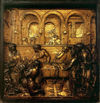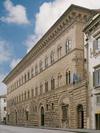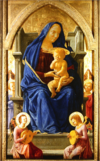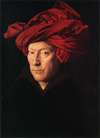Exam 2 Flashcards
What is this?

Sacrifice of Isaac
Artist: Brunelleschi
Early Italian Renaissance (1400-1495)
- Runner Up in the competition panel.
- The competition: artists had to do several things-must use the quatrefoil, you must do the Sacrifice of Isaac, gold leaf, cast bronze relief.
- Isaac is on the altar, Abraham is next to him (sword in hand), angel (told him to stop, messenger of God), they used a lamb instead.
What is this?

Sacrifice of Isaac
Artist: Ghiberti
Early Italian Renaissance (1400-1495)
- Won the competition panel.
- Ghiberti did the second set of doors (Life of Christ).
- The Pisano doors where moved to the south.
- The Ghiberti doors are now the main doors facing the cathedral.
- The doors are very similar to the old doors.Installed in 1420.
What is this?

The Four Crowned Martyrs
Artist: Nanni DiBanco
Early Italian Renaissance (1400-1495)
- Marble statues, contrapposto stance, story is of four sculptures in Ancient Roman days, Christians and refused to make a pagan idol, they were killed and martyred.
- Life size figures, in the round.
- Below the relief shows them in a studio making the idols.
- It was commissioned from the stone cutters and wood cutters guild.
What is this?

St. George
Early Italian Renaissance (1400-1495)
Artist: Donatello
- Traditional represented wearing armor.
- St. George slayed a dragon.
- The relief below St George is him riding his horse spearing a dragon.
- A grateful woman on his right because the dragon was going to eat her.
- Paid for by the sword-smith making guild.
- Sculpture in the round, close to the edge, acting like he could step down to protect the community.
- Contrapposto stance, good over evil.
What is this?

Feast of Herod
Artist: Donatello
Early Italian Renaissance (1400-1495)
- He did more stone work, not cast bronzing, gold leaf. Donatello learned cast bronzing from Ghirberti. *1st time in relief that linear one point perspective is used, that he got from Brunelleschi.
- The daughter wanted Herod to dance at her bday party, Herod said only if u give me st. john on a platter. but in the panel Herod is pretending he does not know they did this in order to save face in the public.
What is Orsanmichele
Formerly a grain warehouse. Became a church around 1380. Between the cathedral and the town hall. Becomes a public works building. The guilds decorated the building and created reliefs and sculptures around the whole building.
What is this?

Gates of Paradise
Artist: Ghiberti
Early Italian Renaissance (1400-1495) East doors of San Giovanni Baptistry
3 doors, the last door created by Ghirberti
Ghirberti’s first doors where boring and looked like the Pisano doors, so they moved them to another side of the building and ordered the commission to Ghirberti to create another set of doors.
-Ghirberti’s 1st doors were moved to north doorway. 2nd doors are remarkably different. nicknamed “the gates of paradise”.
- 10 panels compared to 28, gold leaf is everywhere compared to the others (only raised pieces)
- subject matters are from the old testament. scenes dealing with creation and king solomon, and queen Sheeba.
- Self portrait: sticking out on both doors Ghirberti did. located in the framework, high relief. the turban headress was common to wear in the 15th century.
What is this?

Jacob and Esau panel from the Gates of Paradise
Artist: Ghiberti
Early Italian Renaissance (1400-1495)
- 3rd panel on right down: most celebrated. 3 tons of bronze. gold leaf. subject: Isaac and jacob.
- Jacob is the sone of Isaac.
- Two sons: Jacob and Esau (1st born).
- Jacobs mother favored him more, and instigates Jacob getting just as much as Esau.
- Jacob gets blessed.
What is this?

David
Artist: Donatello
Early Italian Renaissance (1400-1495)
- 1446-60, not record until 1469. Approx 5 ft tall. One casting. Not meant to a public statue.
- 1st 3D free standing cast bronze sculpture since the ancient romans and greeks.
- Commissioned by the Medici family.
- Religious figure: david (old testament). standing over the head of goliath. he is only wearing boots and a hat, fully nude. contrapposto stance, but exaggerated. He looks very feminine. david was a young boy when he slayed goliath, so to show him nude and w the exaggerated stance shows him young.
What is this?

David
Artist: Verrocchio
Early Italian Renaissance (1400-1495)
- 1470, 2 castings. Head is another casting.
- commissioned for the medici family.
- stronger definition.
- no politics-no helmets.
- no sexual scene of david playing with the head-its in the front of him.
- shorter sword, looks on guard still, suggesting the muscle tone as well. .
What is linear perspective?
- foreshortening of objects
- Orthogonals to the picture plane converge on a single vanishing point
- The size of objects is proportionate to their distance from the observer.
What is this?

Equestrian monument of Erasmo Da Narni
Artist: Donatello
Early Italian Renaissance (1400-1495)
- Must look up, muscular horse, one leg raised.
- Darnari sits on top the horse in full military garb as if he is riding threw the streets.
- Looks almost exactly like the Marcus Aurelius equestrian sculpture.
What is this?

Mary Magdalen c. 1450
Artist: Donatello
Early Italian Renaissance (1400-1495)
Altarpiece in St. John Baptist Church
Florence, Italy
Carved from white poplar wood and painted.
-She is very boney, skinny, wearing rags, very expressive.
-She is usually painted very beautiful.
-Contrapposto pose
-It was in the St. Baptist flood, it took many years to dry out and then restore it.
-He painted veins in her legs, sprinkled with gold dust, the dress is actually her hair, she fasted for 30 years.
What is this?

dome of the Florence Cathedral c.1418-1420’s
Architect: Brunelleschi
Early Italian Renaissance (1400-1495)
Santa maria del Flora Cathedral, Florence, Italy
Created a dome for main cathedral, polygonal dome, not circular, double shell dome
300 ft tall, 138 ft in diameter
- Gothic style. A major dome has not been done since roman times, Brunelleschi kept how he was going to do it a secret.
- He created one of the most amazing feats of engineering. For the first time he built models of the dome, made special equipment to create the dome, and he needed to add the dome to an already made building.
- Both the Foundling Hospital and the dome was created during the same time.
- The largest masonry dome in the world.
- Lantern at top (1470s) Brunelleschi did not do.
- This is the cathedral across from the St. John the Baptistry with the special doors facing it.
- The building becomes a landmark.
- Only one side has an artificial arcade because Michaelangelo said it looked like a “cage of crickets.”
- Circular portholes are used for symbolic meanings.
What is this?

Foundling Hospital c.1421-24
Architect: Brunelleschi
Early Italian Renaissance (1400-1495)
- Brunelleschi becomes celebrated as a architect.
- This hospital takes cares of unwanted children and orphans.
- A civic hospital, taken care of by the community.
- The guilds of Florence, silk and goldsmiths guilds paid for the cost of the building.
- There is no gothic design, more of a greek or roman design.
- The loggia is made up of a series of round arches and Corinthian columns.
- The roof over hangs to create a shadow or a band across to make your eye look horizontal.
- Brunelleschi used grey stone for the architecture areas, walls are white.
- Pendentives are used along the inside of the porch.
- A secret spinning table was created so that mothers could leave their children without anyone seeing them; they could place the child on the table and spin the table so the child would spin to be inside the building.
- Relief sculptures, contrapposta, blue background, done in terra cotta of children along the front of the building indicating the building is for children.
What is this?

San Lorenzo
Brunelleschi
Early Italian Renaissance (1400-1495)
- Commissioned by the Medichi family, a family chapel.
- Flat roof, no stained glass windows, natural white light, looks a lot like the Fondling building
- The Medici family house of worship, commissioned Brunelleschi to rebuilt a church.
- Looking down the nave. Michaelangelo designed the tombs and library later on.
- Brunelleschi made a traditional romanesque church.
- Transept separates the public from the most sacred (alter).
- Dome in center of transept
- Pendentive (initially used in byzantine) which changes a square in a dome shape.
- Free standing Corinthian columns, entablatures, grey stone to make the architecture stand out.
- Flat ceiling, coffers on the ceilings (inset square panel usually decorated).
- White natural light, no stained glass-making it even brighter.
- Donatello, Medici family are buried in their tombs.
- He connected the look to St.Pauls outside the walls, Rome, Italy (Early Christian • Basilica)
What is a condottieri
military leaders (commanders) for hire
What is this?

Pallazo Rucellai family house c.1455-58
Architect: Alberti
Early Italian Renaissance (1400-1495)
- Same as Michaelangelo house, 3 stories
- uses doric columns at ground level, ionic on the middle, corinthian at the top. (just like the roman colosseum)
- entablature to separate the levels
What is a loggia?
large entrance porch, as long as the building runs.
What is a pediment?
top triangle
What is a pendentive?
used back in byzantine, architecture device that enables the square floor to be covered by a dome.
Explain corinthian columns
Very decorative columns, long and slim, swirls, flowers, and fluted columns.























